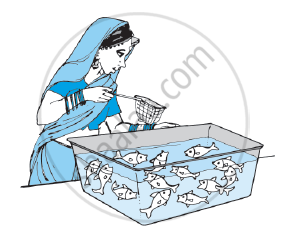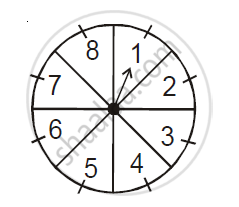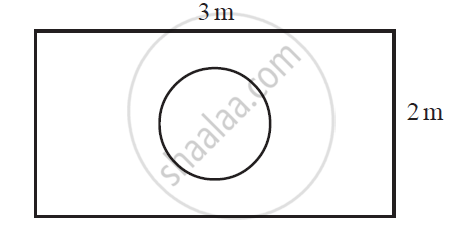Advertisements
Online Mock Tests
Chapters
2: Polynomials
3: Pair of Linear Equations in Two Variables
4: Quadratic Equations
5: Arithmetic Progressions
6: Triangles
7: Coordinate Geometry
8: Introduction to Trigonometry
9: Some Applications of Trigonometry
10: Circles
11: Areas Related to Circles
12: Surface Areas and Volumes
13: Statistics
▶ 14: Probability
![NCERT solutions for Mathematics [English] Class 10 chapter 14 - Probability NCERT solutions for Mathematics [English] Class 10 chapter 14 - Probability - Shaalaa.com](/images/mathematics-english-class-10_6:d0d325cb7c8b4eec9c122c10141a5707.jpg)
Advertisements
Solutions for Chapter 14: Probability
Below listed, you can find solutions for Chapter 14 of CBSE, Karnataka Board NCERT for Mathematics [English] Class 10.
NCERT solutions for Mathematics [English] Class 10 14 Probability EXERCISE 14.1 [Pages 214 - 216]
Complete the following statements:
Probability of an event E + Probability of the event ‘not E’ = _______.
The probability of an event that cannot happen is _________. Such as event is called _________.
The probability of an event that is certain to happen is ______. Such as event is called ______.
The sum of the probabilities of all the elementary events of an experiment is _________.
The probability of an event is greater than or equal to ______ and less than or equal to ______.
Following experiment have equally likely outcomes? Explain.
A driver attempts to start a car. The car starts or does not start.
Following experiment have equally likely outcomes? Explain.
A player attempts to shoot a basketball. She/he shoots or misses the shot.
Following experiment have equally likely outcomes? Explain.
A trial is made to answer a true-false question. The answer is right or wrong.
Following experiment have equally likely outcomes? Explain.
A baby is born. It is a boy or a girl.
Why is tossing a coin considered to be a fair way of deciding which team should get the ball at the beginning of a football game?
Which of the following cannot be the probability of an event?
`2/3`
–1.5
15%
0.7
If P(E) = 0.05, what is the probability of ‘not E’?
A bag contains lemon flavoured candies only. Malini takes out one candy without looking into the bag. What is the probability that she takes out an orange flavoured candy?
A bag contains lemon flavoured candies only. Malini takes out one candy without looking into the bag. What is the probability that she takes out a lemon flavoured candy?
It is given that in a group of 3 students, the probability of 2 students not having the same birthday is 0.992. What is the probability that the 2 students have the same birthday?
A bag contains 3 red balls and 5 black balls. A ball is drawn at random from the bag. What is the probability that the ball drawn is red?
A bag contains 3 red balls and 5 black balls. A ball is drawn at random from the bag. What is the probability that the ball drawn is not red?
A box contains 5 red marbles, 8 white marbles, and 4 green marbles, One marble is taken out of the box at random. What is the probability that the marble taken out will be red?
A box contains 5 red marbels, 8 white marbles and 4 green marbles, One marble is taken out of the box at ramdom. What is the probability that the marble taken out will be white?
A box contains 5 red marbles, 8 white marbles and 4 green marbles. One marble is taken out of the box at randam.What is the probability that the marble taken out wil be not green?
A piggy bank contains hundred 50 p coins, fifty Rs 1 coins, twenty Rs 2 coins and ten Rs 5 coins. If it is equally likely that one of the coins will fall out when the bank is turned upside down, what is the probability that the coin will be a 50 p coin?
A piggy bank contains hundred 50 p coins, fifty Rs 1 coins, twenty Rs 2 coins and ten Rs 5 coins. If it is equally likely that one of the coins will fall out when the bank is turned upside down, what is the probability that the coin will not be a Rs. 5 coin?
Gopi buys a fish from a shop for his aquarium. The shopkeeper takes out one fish at random from a tank containing 5 male fish and 8 female fish (see Figure). What is the probability that the fish taken out is a male fish?

A game of chance consists of spinning an arrow which comes to rest pointing at one of the numbers 1, 2, 3, 4, 5, 6, 7, 8 (see the given figure), and these are equally likely outcomes. What is the probability that it will point at
- 8?
- an odd number?
- a number greater than 2?
- a number less than 9?

A die is thrown once. Find the probability of getting a prime number.
A die is thrown once. Find the probability of getting a number lying between 2 and 6.
A die is thrown once. Find the probability of getting an odd number.
One card is drawn from a well-shuffled deck of 52 cards. Find the probability of getting a king of red colour.
One card is drawn from a well-shuffled deck of 52 cards. Find the probability of getting a face card.
One card is drawn from a well-shuffled deck of 52 cards. Find the probability of getting a red face card.
One card is drawn from a well-shuffled deck of 52 cards. Find the probability of getting the jack of hearts.
One card is drawn from a well-shuffled deck of 52 cards. Find the probability of getting a spade.
One card is drawn from a well-shuffled deck of 52 cards. Find the probability of getting the queen of diamonds.
Five cards, the ten, jack, queen, king and ace of diamonds, are well-shuffled with their face downwards. One card is then picked up at random. What is the probability that the card is the queen?
Five cards, the ten, jack, queen, king, and ace of diamonds, are well-shuffled with their face downwards. One card is then picked up at random.
If the queen is drawn and put aside, what is the probability that the second card picked up is (a) an ace? (b) a queen?
12 defective pens are accidentally mixed with 132 good ones. It is not possible to just look at a pen and tell whether or not it is defective. One pen is taken out at random from this lot. Determine the probability that the pen taken out is a good one.
- A lot of 20 bulbs contain 4 defective ones. One bulb is drawn at random from the lot. What is the probability that this bulb is defective?
- Suppose the bulb drawn in (1) is not defective and is not replaced. Now one bulb is drawn at random from the rest. What is the probability that this bulb is not defective?
A box contains 90 discs which are numbered from 1 to 90. If one disc is drawn at random from the box, find the probability that it bears a two-digit number.
A box contains 90 discs which are numbered from 1 to 90. If one disc is drawn at random from the box, find the probability that it bears a perfect square number.
A box contains 90 discs which are numbered from 1 to 90. If one disc is drawn at random from the box, find the probability that it bears a number divisible by 5.
A child has a die whose six faces shows the letters as given below:
| A | B | C | D | E | A |
The die is thrown once. What is the probability of getting (i) A? (ii) D?
Suppose you drop a die at random on the rectangular region shown in the given figure. What is the probability that it will land inside the circle with diameter 1m?

A lot consists of 144 ball pens of which 20 are defective and the others are good. Nuri will buy a pen if it is good, but will not buy if it is defective. The shopkeeper draws one pen at random and gives it to her. What is the probability that she will buy it?
A lot consists of 144 ball pens, of which 20 are defective and the others are good. Nuri will buy a pen if it is good, but will not buy if it is defective. The shopkeeper draws one pen at random and gives it to her. What is the probability that she will not buy it?
Two dice, one blue and one grey, are thrown at the same time.
(i) Write down all the possible outcomes and complete the following table:
| Event : ‘Sum on 2 dice’ |
2 | 3 | 4 | 5 | 6 | 7 | 8 | 9 | 10 | 11 | 12 |
| Probability | `1/36` | `5/36` | `1/36` |
A game consists of tossing a one rupee coin 3 times and noting its outcome each time. Hanif wins if all the tosses give the same result, i.e., three heads or three tails, and loses otherwise. Calculate the probability that Hanif will lose the game.
A die is thrown twice. What is the probability that
- 5 will not come up either time?
- 5 will come up at least once?
[Hint: Throwinga die twice and throwing two dice simultaneously are treated as the same experiment].
Are the arguments in the following sentence correct or not correct? Give a reason for your answer.
If two coins are tossed simultaneously there are three possible outcomes, two heads, two tails or one of each. Therefore, for each of these outcomes, the probability is `1/3.`
Correct
Incorrect
Which of the following arguments are correct and which are not correct? Give a reason for your answer.
If a die is thrown, there are two possible outcomes, an odd number or an even number. Therefore, the probability of getting an odd number is 1/2.
Correct
Incorrect
Solutions for 14: Probability
![NCERT solutions for Mathematics [English] Class 10 chapter 14 - Probability NCERT solutions for Mathematics [English] Class 10 chapter 14 - Probability - Shaalaa.com](/images/mathematics-english-class-10_6:d0d325cb7c8b4eec9c122c10141a5707.jpg)
NCERT solutions for Mathematics [English] Class 10 chapter 14 - Probability
Shaalaa.com has the CBSE, Karnataka Board Mathematics Mathematics [English] Class 10 CBSE, Karnataka Board solutions in a manner that help students grasp basic concepts better and faster. The detailed, step-by-step solutions will help you understand the concepts better and clarify any confusion. NCERT solutions for Mathematics Mathematics [English] Class 10 CBSE, Karnataka Board 14 (Probability) include all questions with answers and detailed explanations. This will clear students' doubts about questions and improve their application skills while preparing for board exams.
Further, we at Shaalaa.com provide such solutions so students can prepare for written exams. NCERT textbook solutions can be a core help for self-study and provide excellent self-help guidance for students.
Concepts covered in Mathematics [English] Class 10 chapter 14 Probability are Sample Space, Concept Or Properties of Probability, Simple Problems on Single Events, Probability - A Theoretical Approach, Basic Ideas of Probability, Basic Ideas of Probability, Sample Space, Concept Or Properties of Probability, Simple Problems on Single Events, Probability - A Theoretical Approach, Basic Ideas of Probability, Basic Ideas of Probability, Sample Space, Concept Or Properties of Probability, Simple Problems on Single Events, Probability - A Theoretical Approach, Basic Ideas of Probability, Basic Ideas of Probability.
Using NCERT Mathematics [English] Class 10 solutions Probability exercise by students is an easy way to prepare for the exams, as they involve solutions arranged chapter-wise and also page-wise. The questions involved in NCERT Solutions are essential questions that can be asked in the final exam. Maximum CBSE, Karnataka Board Mathematics [English] Class 10 students prefer NCERT Textbook Solutions to score more in exams.
Get the free view of Chapter 14, Probability Mathematics [English] Class 10 additional questions for Mathematics Mathematics [English] Class 10 CBSE, Karnataka Board, and you can use Shaalaa.com to keep it handy for your exam preparation.
